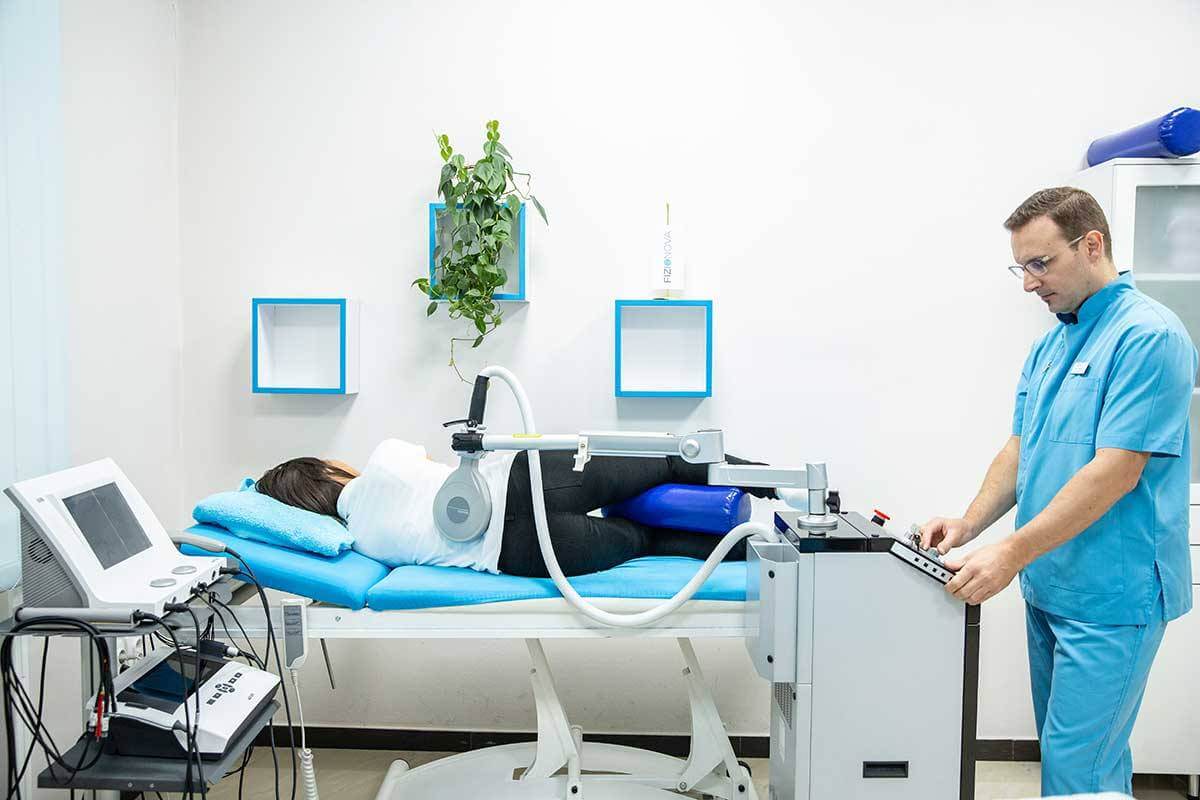Spinal decompression technique involves relieving pressure on spinal discs and creating negative pressure within the disc.
As a result, bulging or herniated discs retract, reducing pressure on nerves and other structures in the spine.
Additionally, it improves blood circulation in the affected area and promotes disc healing.
Non-surgical spinal decompression is used to treat the following conditions:
- Cervical syndrome (neck pain), back pain, and sciatica
- Disc herniation and degenerative spinal conditions
- Compressive fractures in chronic stages
Benefits of spinal decompression
Spinal decompression has been proven to increase the intervertebral space by up to 2.5 millimeters. This increase helps unblock intervertebral joints, stretches ligaments, muscles, and fibroelastic tissues.
Moreover, it enhances vascularization in compromised tissues, facilitating their recovery and healing.
Spinal decompression as a non-surgical treatment for disc herniation at Fizionova Center
Thanks to this innovative method, Fizionova Center provides treatments for disc herniation that entirely bypass the need for surgery.
Considering that disc herniation is essentially an injury to the intervertebral disc of the spinal column, caused by herniation, prolapse, and penetration of the gelatinous core of the intervertebral disc into intervertebral openings, leading to pressure on the roots of spinal nerves, and sometimes pressure on the spinal canal and the space where the spinal cord is located, spinal decompression has proven to be an excellent method for treating disc herniation.
In short, spinal decompression achieves relief by removing pressure from nerves affected by the disc, allowing the mass from the herniated disc to retract.
Protocols for Disc Herniation at Our Center
The basic and most common types of disc herniation are lumbar disc herniation.
Lumbar disc herniation: It initially manifests as back muscle pain. If left untreated, degenerative changes occur in the affected vertebrae and the disc between them.
In the advanced stage of lumbar syndrome, neurological pain arises due to disc pressure on nerve roots.
This pain often radiates down the buttocks and legs (through the back of the thigh) and extends all the way to the calves or the entire leg, including the feet. Another type of pain around the waist suggests central pressure on the spinal cord.
At Fizionova Center, we treat lumbar and cervical disc herniation with the following protocols:
Protocol Number 4 for lumbar disc herniation
- SALUS TALENT
- RSQ treatment
- GYMNA LASER - pain relief
- GYMNA PROGRAM pain relief-TENS
- Chattanooga Triton DTS traction table
- Spinal decompression following manipulation
- RSQ1 device treatment (electrotherapy)
- Physiotherapy (movement therapy)
- Combined therapy (ultrasound and electrotherapy)
- Cryotherapy with Irradia cold laser
- High-frequency magnet therapy with Salus Talent device
- Hyperbaric therapy (for severe herniation cases)
Protocol Number 2 for Cervical Syndrome:
- Cryotherapy
- GYMNA - program for hip joint arthrosis, bipolar GYMNA ultrasound
- SALUS TALENT
- RSQ treatment
- GYMNA HAN-STIM
- GYMNA LASER - pain relief
- Kinesiology tape
- Chattanooga Triton DTS traction table
There are two main types of cervical syndrome, differing based on the vertebra segment where the problem occurs.

Cervicocerebral Syndrome
When changes occur in the segment from the first to the C4 vertebra, it is referred to as cervicocerebral syndrome. Symptoms associated with this syndrome include tension headaches (especially in the occipital region), as well as ringing in the ears and flickering lights before the eyes, which are often misattributed to high blood pressure.
Cervicobrachial Syndrome
In cases where changes occur in the segment from C4 to Th1 vertebra, it is termed cervicobrachial syndrome. Symptoms associated with this syndrome include tingling and numbness in the hands accompanied by loss of sensation and control in the fingers, as well as shoulder pain. Morning and nighttime pain are common in this condition due to disc hydration, leading to painful sensations.
Due to the similar root cause of these problems, Protocol Number 2 shares several aspects with Protocol Number 4. Of course, spinal decompression of the cervical region is one of the initial treatments in this protocol.
Next comes the RSQ1 treatment. It's worth mentioning that 21 minutes of RSQ1 therapy is as effective as 90 minutes of exercise.
Initially, RSQ1 is administered solely through relaxation, and from the second or third session, kinesiotherapy with the mentioned device is added.
Then comes the Hans Tim treatment, which involves mild electrotherapy to assist in relaxing the deep neck muscles.
A combined therapy follows – a combination of TENS and sonophoresis. In the case of cervicobrachial syndrome, this therapy treats the entire arm, while in the case of cervicocerebral syndrome, it covers only the shoulder-scapular area.
The next procedure used to treat cervical syndrome is Salus Talent (high-frequency magnet treatment). It is an electromagnetic stimulator starting with milder frequencies, gradually increasing with each subsequent session.
Additionally, cryotherapy is applied using Irradia cold laser.
For more severe conditions, hypobaric therapy is included.
Therefore, if you have disc herniation or other types of back or neck pain and want to explore the possibility of non-surgical treatment, feel free to call us and schedule an appointment with our doctors.
SCHEDULE A PHYSIATRIST'S EXAMINATION
Dr Jelena Kluz-Đurđević, a specialist in physical medicine
After a conversation with the patient, Dr. Jelena will conduct an examination to obtain a more comprehensive view of your health status, helping to determine whether it's an injury or a diagnosis.
The examination lasts for 30 minutes and includes:
Schedule a specialist examination by calling 011 2100 588 for the cost of 4,000 RSD.
